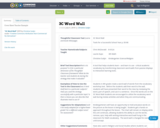
Cover Sheet
Teacher Example
- Subject:
- Education
- Elementary Education
- English Language Arts
- History
- Mathematics
- Physical Science
- Social Science
- Material Type:
- Activity/Lab
- Date Added:
- 07/06/2019

Cover Sheet
Teacher Example
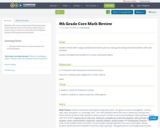
Students will create an interactive Powerpoint game where they will create real world problems that are used as clues to move on to the next level. Problems include all 8th grade math standards.
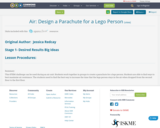
This STEM challenge can be used during an air unit. Students work together in groups to create a parachute for a lego person. Students are able to find ways to best maximize air resistance. The students need to find the best way to increase the time that the lego person stays in the air when dropped from the second floor to the first floor.
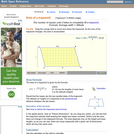
A web page and interactive applet showing the ways to calculate the area of a trapezoid. The user can drag the vertices of the trapezoid and the other points change automatically to ensure it remains a trapezoid. A grid inside the shape allows students to estimate the area visually, then check against the actual computed area. The text on the page gives three different ways to calculate the area with a formula for each. The applet uses one of the methods to compute the area in real time, so it changes as the trapezoid is reshaped with the mouse. A companion page is http://www.mathopenref.com/trapezoid.html showing the definition and properties of a trapezoid. Applet can be enlarged to full screen size for use with a classroom projector. This resource is a component of the Math Open Reference Interactive Geometry textbook project at http://www.mathopenref.com.
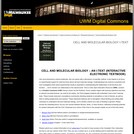
Like most introductory science textbooks, this one opens with a discussion of scientific method. A key feature is its focus on experimental support for what we know about cell and molecular biology. Understanding how science is practiced and how investigators think about experimental results is essential to understanding the relationship of cell structure and function…, not to mention our relationship to the natural world. This is a free Open Education Resource (OER), covered by a Creative Commons CCBY license (check out the Preface!). Every chapter begins with learning objectives and links to relevant recorded lectures. As used by the author, the iText engages students with embedded “just-in-time” learning tools. These include instructor’s annotations (comments) directing students to animations or text of interest, as well as links to writing assignments and quizzes. These interactive features aim to strengthen critical thinking and writing skills necessary to understand cell and molecular biology, not to mention science as a way of thinking in general. Please excuse the marketing terms, but you can choose between Bronze, Silver, or Gold versions, reflecting increasing potential for student interaction with the iText. Download your choice of the iText or the sample chapter at one of the links below.

This course will explore the state of the art in common sense knowledge, and class projects will design and build interfaces that can exploit this knowledge to make more usable and helpful interfaces.
Course requirements will consist of critiques of class readings (about 2 papers/week), and a final project (paper or computer implementation project). Grades will be based primarily on the projects, as well as a small component for class and online participation

Name of Student Teacher: Vannesa Tovar Díaz, Camila Guzmán Cruz, Diana Oyola Ortiz, Sebastián Perdomo, Leonardo Hernández.School/Institution: Institución Educativa Departamental Tierra de Promisión.Grade: Ninth Grade.Length of the Class: 2 hours.

This course explores visualization methodologies to conceive and represent systems and data, e.g., financial, media, economic, political, etc., with a particular focus on climate change data in this version of the course. Topics include basic methods for research, cleaning, and analysis of datasets, and creative methods of data presentation and storytelling. The course considers the emotional, aesthetic, ethical, and practical effects of different presentation methods as well as how to develop metrics for assessing impact. Coursework includes readings, visualization exercises, and a final project.
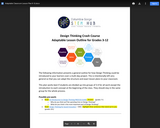
This is a highly adaptable outline for how design thinking could be introduced to your learners over a multi-day project. This plan works best if students are divided up into groups of 3-4 for all work except the introduction to each concept at the beginning of class. Learners should stay in the same group for the whole class.
Includes pre-work links, general instructions to guide planning for each day, design thinking student handouts, and multi-grade NGSS standards linked to design thinking.
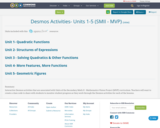
Interactive Desmos activities that are associated with Units of the Secondary Math II - Mathematics Vision Project (MVP) curriculum.
Teachers will want to create a class code to share with students to monitor student progress as they work through the Desmos activities for each of the lessons.
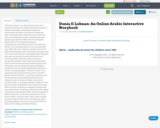
“Dunia Fi Lubnan” is an online Arabic interactive storybook developed by Alefb multicultural center for children with support from Qatar Foundation International through a Curriculum Development grant.
The storybook is a fully illustrated interactive story, and includes interactive comprehension quiz questions prompted by "Nahla the bee" in English, playful drills to test reading, writing and comprehension, and cultural games from which the learner can accumulate points to earn a surprise gift from Alefb. The story of Dunia, stretched out over 22 fully illustrated pages, tells a tale about a young girl who tries to overcome her fear of speaking Arabic. Along the way, users are exposed to several interactive self-correcting drills, audio files, cultural authentic documents tackling a wide variety of learning topics based on the themes and lessons within Dunia's story. Animations, sounds, glossaries pages and English translation tools all provide helpful hints and aid the learner in staying engaged. “Dunia Fi Lubnan” is an integrated educational material in that it uses both Modern Standard Arabic, الفصحى and colloquial العامية.
The interactive and multimedia components are designed in part to enhance regular curricula for teaching Arabic as a foreign language to children, teens and even adults, individually or in a classroom setting.
When all of the modules are completed, learners will have acquired new vocabulary, reinforced their reading, writing and comprehension skills, and been exposed to different practices, products and perspectives of the Arabic culture. Learners will be able to write a simple postcard using vocabulary from the following topics: Greetings, Feelings, Activities, Countries and Places, Colors, Food, Things and Family/Friends.
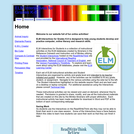
Welcome to our website full of fun online activities! ELM Interactives for Grades K-8 is designed to help young students develop and practice computer, online literacy and research skills. ELM Interactives for Students is a collection of instructional activities on the Electronic Library for Minnesota (ELM) databases created by librarians in the Reference Outreach and Instruction unit of Minitex utilizing the Student Interactives hosted on the ReadWriteThink site and provided by the International Reading Association, National Council of Teachers of English, and the Verizon Foundation's Thinkfinity. Each set of ELM instructional activities and Student Interactives are organized by activity and grade level and intended to be teacher initiated and guided. However, any of the activities can be modified to fit any grade, student, or assignment. The Student Interactives highlighted on this website require Flash and are best used on a desktop or laptop computer. These instructional activities can be viewed and used on-demand, whenever they're needed.
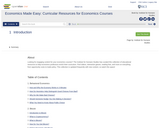
Looking for engaging content for your economics courses? The Institute for Humane Studies has curated this collection of educational resources to help economics professors enrich their curriculum. Find videos, interactive games, reading lists, and more on everything from opportunity costs to trade policy. This collection is updated frequently with new content, so watch this space!

Consider the need for home education for Black and African-American families in Southern Maryland in the 1870s through 1920s, when public education was unavailable or inaccessible. This resource combines 3D models and 2D interaction to introduce students to Alphabet Wares/Alphabet Plates as found at Jefferson Patterson Park and Museum when excavating "Sukeek's Cabin," a late-19th century home by a newly-freed family on the park grounds. Themes include unjust limitations, archaeology as a primary source, and home life in the 1870s-1920s. The resource includes simple prompts and resources for hypothesizing about archaeological findings, researching them, drawing conclusions, and suggestions for further reflection.
This resource uses Genial.ly, an online-presentation service, with additional tools by S'CAPE to increase the interactivity. Public Genial.lys may be remixed into new presentations after signing up for an account with the service.
This resource is part of Jefferson Patterson Park and Museum’s open educational resources project to provide history, ecology, archaeology, and conservation resources related to our 560 acre public park. More of our content can be found on OER Commons, YouTube, and SketchFab. JPPM is a part of the Maryland Historical Trust under the Maryland Department of Planning.

This learning object is an interactive PowerPoint tutorial addressing effective communication practices to be used by online instructional personnel.

The Network of Conservation Educators and Practitioners (NCEP) produces peer-reviewed teaching resources summarizing topics on conservation biology. Each module contains a synthesis document outlining the main concepts of a subject, a modifiable visual presentation, classroom exercises and solutions, teaching notes, and interdisciplinary case studies. For more information please visit where all NCEP modules are available free of charge.
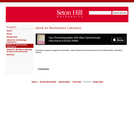
This ebook contains background information, video tutorials and virtual exercises for the Biochemistry Laboratory module. Gas chromatography (GC) and mass spectrometry (MS) are analysis methods that require a lot of background information and intense theory. This interactive ebook will help you understand the information behind these analysis methods, and is accessible through iTunes.

Install the Google Arts & Culture app to explore virtual reality tours from Smithsonian's National Air and Space Museum.

If you were a government official trying to raise revenue, who would you tax? Pick whether to tax cigarettes, luxury goods, or oil and gas in this interactive game and Professor Art Carden of Samford University will explain how the market will react.
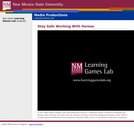
In this interactive, learners develop the skills to handle a horse safely before entering the corral for the first time. The interactive consists of three stages, each explaining an aspect of the safety procedures necessary for leading a horse.